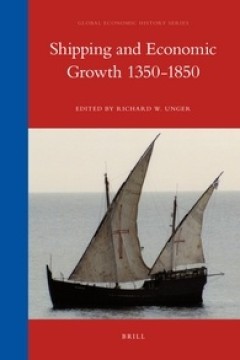Ditapis dengan

The growth potential of container shipping on the Yangtze River
Despite the rapid economic growth in the Yangtze River Delta area, the Yangtze River itself is lagging behind as measured by the ratio of container volume to total freight volume. According to the Ministry of Communications’ statistics, more than 70% of cargoes generated in the Yangtze Valley are suitable for containerized transport, but, at this time, only a fraction of these cargoes are act…
- Edisi
- VOL. 35, NO. 6, 535–549
- ISBN/ISSN
- 1464–5254
- Deskripsi Fisik
- 17 p.
- Judul Seri
- Maritime Policy & Management: The flagship journal of international shipping and port research
- No. Panggil
- ATC LO VEE t

The role of human capital in economic development Evidence from aggregate cro…
Using cross-country estimates of physical and human capital stocks, we run the growth accounting regressions implied by a CobbPDouglas aggregate production function. Our results indicate that human capital enters insignificantly in explaining per capita growth rates. We next specify an alternative model in which the growth rate of total factor productivity depends on a nation’s human capital …
- Edisi
- -
- ISBN/ISSN
- 0304-3932;9
- Deskripsi Fisik
- 31 p.
- Judul Seri
- Journal of Monetary Economics
- No. Panggil
- ATC MG BEN t c.1

Effective societal knowledge management
- Edisi
- Vol. 11 Iss 5 pp. 141 - 156
- ISBN/ISSN
- -
- Deskripsi Fisik
- 18 p.
- Judul Seri
- Journal of Knowledge Management
- No. Panggil
- ATC MG WII e
- Edisi
- Vol. 11 Iss 5 pp. 141 - 156
- ISBN/ISSN
- -
- Deskripsi Fisik
- 18 p.
- Judul Seri
- Journal of Knowledge Management
- No. Panggil
- ATC MG WII e

Shipping and economic growth 1350–1850
- Edisi
- -
- ISBN/ISSN
- 978-90-04-19439-7
- Deskripsi Fisik
- xix, 464 p.
- Judul Seri
- -
- No. Panggil
- TXT LO UNG s
- Edisi
- -
- ISBN/ISSN
- 978-90-04-19439-7
- Deskripsi Fisik
- xix, 464 p.
- Judul Seri
- -
- No. Panggil
- TXT LO UNG s

Port infrastructure investment and regional economic growth in China : panel …
- Edisi
- -
- ISBN/ISSN
- 0967-070X
- Deskripsi Fisik
- 11 p.
- Judul Seri
- Transport Policy
- No. Panggil
- ATC PO SON p
- Edisi
- -
- ISBN/ISSN
- 0967-070X
- Deskripsi Fisik
- 11 p.
- Judul Seri
- Transport Policy
- No. Panggil
- ATC PO SON p

An empirical investigation of the seaport’s economic impact : Evidence from…
In this study, we investigate the impact of the seaport on host city’s economic development. Based on data from 41 major port cities in China over the period 2003–2010, our econometric analysis shows that port cargo throughput has a positive effect on the economic growth of the host city. In addition, the competing ports in the neighborhood have an even larger positive association with the …
- Edisi
- -
- ISBN/ISSN
- -
- Deskripsi Fisik
- 13 p.
- Judul Seri
- -
- No. Panggil
- ATC PO SHA a

Logistics: Perspectives for the 1990s
The decade of the 1980s has been witness to a long period of stable, sustained economic growth in the American economy, with moderate inflation, favourable interest rates, and steady growth in GNP. The decade has been remarkably free of the economic turmoil that marred the 1970s ‐ double digit inflation, double digit prime interest rates, the energy crisis. Nevertheless, the last nine years h…
- Edisi
- Vol. 1 Issue: 1, pp.1-6
- ISBN/ISSN
- -
- Deskripsi Fisik
- 8 p.
- Judul Seri
- The International Journal of Logistics Management
- No. Panggil
- ATC LO MAS l

Power Generation, FSRUs To Underpin EM LNG Growth
Strong LNG demand growth in Asia's less-established LNG players including Bangladesh, Myanmar, Pakistan, the Philippines and Vietnam will absorb some of the forthcoming oversupply in the global LNG market. FSRUs will provide these players with cheaper, quicker access to LNG, building a platform for stronger offtake in the power, industrial, residential and transportation sectors. Asia's…
- Edisi
- -
- ISBN/ISSN
- -
- Deskripsi Fisik
- 2 p.
- Judul Seri
- -
- No. Panggil
- BD BMI p

Hydro Dominance To Continue Amid Weak Power Sector Growth
Cambodia ' s power generation mix will be dominated by hydropower over the coming decade, accounting for more than 60% of total electricity generation by 2026. Growth in the power sector will be slow, as project delays and an unattractive investment environment clouds the sector ' s expansion. Cambodia's power sector will remain heavily reliant on hydropower over our 10-year forecas…
- Edisi
- -
- ISBN/ISSN
- -
- Deskripsi Fisik
- 3 p.
- Judul Seri
- -
- No. Panggil
- BD BMI h

Gas growth on the horizon
A solid exploration drilling programme in Myanmar will identify new gas resources, likely sufficient to support new expo rts to either China or Thailand within the next ten years. Exploration drilling in Myanmar continues to deliver positive results, likely leading to an uptick in new wells over the back end of 2017. Woodside Petroleum is leading the charge following a gas discovery at its Pyi …
- Edisi
- -
- ISBN/ISSN
- -
- Deskripsi Fisik
- 2 p.
- Judul Seri
- -
- No. Panggil
- BD BMI g

Indonesia Consumer electronics report : Includes 5-year forecasts to 2021
We have downgraded Indonesia's economic growth forecast to 5.1% in 2017 as the mining sector is showing little sign of picking up despite the easing of the mineral export ban, while the manufacturing and retail and wholesale sectors appear to be on a slight downturn. Rising political risks in the run-up to the 2019 elections are also likely to weigh on growth going into 2018, although we expect…
- Edisi
- -
- ISBN/ISSN
- -
- Deskripsi Fisik
- 42 p.
- Judul Seri
- -
- No. Panggil
- BD BMI i

Affordability Acts As A Barrier To Sales Growth Potential
BMI View: Cambodia ' s imbalance between its Industry scores and Country scores are characteristic of a frontier market which has considerable growth potential but a difficult operating environment. Its high score for vehicle sales growth, which ranks it sixth globally in this component, is threatened by low GDP per capita and high taxes creating affordability issues for consumers.
- Edisi
- -
- ISBN/ISSN
- -
- Deskripsi Fisik
- 2 p.
- Judul Seri
- -
- No. Panggil
- BD BMI a

Growth strategies for logistics service providers: a case study
This article is based on two studies, partly financed by the Norwegian Research Council. The first study was carried out in six organizations cooperating in two supply chain alliances. The purpose of this study was to develop a set of hypotheses concerning logistics service providers and their roles in supply chain alliances. The second study, involved interviews carried out in 12 different log…
- Edisi
- Vol. 12 Issue: 1, pp.53-64
- ISBN/ISSN
- -
- Deskripsi Fisik
- 16 p .
- Judul Seri
- The International Journal of Logistics Management
- No. Panggil
- ATC LO VIR g

Growth of future group logistics – Indian retail company
The purpose of this paper is to develop material for classroom teaching in the subject area of general management with retail industry focus.
- Edisi
- Vol. 23 No. 4/5, 2013 pp. 330-342
- ISBN/ISSN
- -
- Deskripsi Fisik
- 14 p.
- Judul Seri
- Competitiveness Review: An International Business Journal
- No. Panggil
- ATC LO MOH g

Emerging distribution systems in central and Eastern Europe: Implications fro…
The purpose of the research is to shed light on the evolution of distribution structures and its consequent implications for supply chain management (SCM) in the context of the emerging markets of Central and Eastern Europe (CEE).
- Edisi
- Vol. 37 No. 8, 2007 pp. 670-697
- ISBN/ISSN
- -
- Deskripsi Fisik
- 31 p.
- Judul Seri
- International Journal of Physical Distribution & Logistics Management
- No. Panggil
- ATC LO HIL e
 Karya Umum
Karya Umum  Filsafat
Filsafat  Agama
Agama  Ilmu-ilmu Sosial
Ilmu-ilmu Sosial  Bahasa
Bahasa  Ilmu-ilmu Murni
Ilmu-ilmu Murni  Ilmu-ilmu Terapan
Ilmu-ilmu Terapan  Kesenian, Hiburan, dan Olahraga
Kesenian, Hiburan, dan Olahraga  Kesusastraan
Kesusastraan  Geografi dan Sejarah
Geografi dan Sejarah